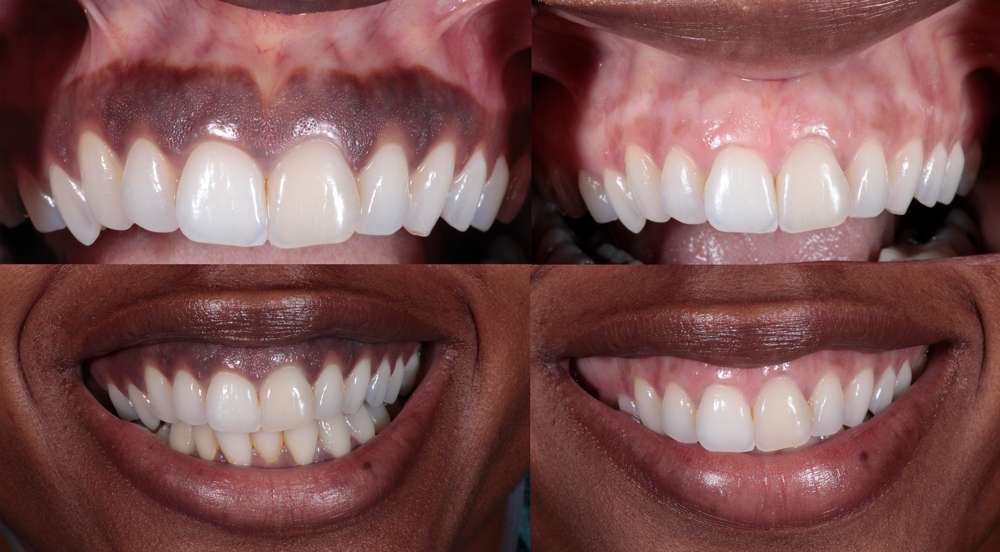Say goodbye to discolored gums with gingival depigmentation
Intro
Are your gums discolored? Are you looking for a way to say goodbye to unsightly dark patches or purplish discoloration on your gums? Gingival depigmentation is the answer! This procedure involves removing excess pigmentation from the gums to restore them to their natural, healthy pink hue. It is a simple and straightforward procedure that can be completed in one visit to your dentist’s office. It not only helps improve the appearance of your gums, but can also help them heal from any damage or irritation caused by the excess pigmentation. So, if you’re looking to improve the look of your gums, consider gingival depigmentation and start smiling again!
Understanding gingival pigmentation
Gingival pigmentation is a common condition that affects the appearance of the gums. It occurs when excess melanin, the pigment responsible for skin and hair color, is present in the gums. This can result in dark patches, streaks, or a general purplish discoloration of the gums.
While the exact cause of gingival pigmentation is not fully understood, it is believed to be influenced by factors such as genetics, hormonal changes, certain medications, smoking, and even certain systemic diseases. It is important to note that gingival pigmentation is not a sign of poor oral hygiene or dental health. However, many people find it aesthetically displeasing and seek treatment to improve the appearance of their gums.
Untreated gingival pigmentation can lead to self-consciousness and decreased self-esteem in individuals. It may also be associated with oral health concerns such as gum inflammation, bleeding, and sensitivity. Therefore, it is important to address this issue and seek treatment if desired.
In the next section, we will delve deeper into the causes of gingival pigmentation and explore the different factors that contribute to this condition. Stay tuned to learn more about this fascinating topic and discover the solution to discolored gums.

Causes of gingival pigmentation
Gingival pigmentation can have various causes, some of which are still not fully understood. One common cause is genetics, as the amount of melanin present in the gums can be inherited from your parents. Hormonal changes, such as those that occur during pregnancy or puberty, can also contribute to increased pigmentation in the gums.
Certain medications, particularly those containing hormones or antimalarial drugs, can cause changes in the pigmentation of the gums. Smoking is another significant factor that can lead to gingival pigmentation, as the toxins in cigarettes can cause the gums to darken.
In addition, certain systemic diseases, such as Addison’s disease or Peutz-Jeghers syndrome, can result in excessive pigmentation of the gums. These conditions affect the production and distribution of melanin in the body, leading to darkening of the gums.
While poor oral hygiene is not a direct cause of gingival pigmentation, inadequate dental care can exacerbate the appearance of discolored gums. Plaque and tartar buildup can make the pigmentation more noticeable, as they create a contrast against the pink color of healthy gums.
It is important to consult with a dental professional to determine the underlying cause of your gingival pigmentation. They can evaluate your oral health, medical history, and lifestyle factors to provide personalized insights and recommend appropriate treatment options. Understanding the causes of gingival pigmentation is the first step towards achieving a healthy and aesthetically pleasing smile.
Risks associated with untreated gingival pigmentation
If left untreated, gingival pigmentation can pose certain risks and concerns. While it is not a direct indication of poor oral hygiene or dental health, the appearance of darkened gums can have a negative impact on an individual’s self-esteem and confidence. The visible discoloration can lead to self-consciousness, causing individuals to hide their smiles and feel uncomfortable in social situations.
In addition to the psychological effects, untreated gingival pigmentation can also have oral health implications. The excess pigmentation can contribute to gum inflammation, also known as gingivitis, which can further lead to more serious gum diseases such as periodontitis. This inflammation can cause the gums to become red, swollen, and prone to bleeding. It may also result in increased gum sensitivity and discomfort.
Furthermore, the presence of excess pigmentation can make it more challenging to detect early signs of gum disease, as the discoloration can mask the redness and swelling that typically accompany these conditions. This can delay necessary treatment, allowing the disease to progress and potentially cause irreversible damage to the gums and supporting structures of the teeth.
Therefore, addressing gingival pigmentation and seeking appropriate treatment is crucial for both aesthetic and oral health reasons. By opting for gingival depigmentation, you can improve the appearance of your gums, restore your confidence, and minimize the risk of developing gum disease. It’s time to take control of your smile and say goodbye to discolored gums for good!
Gingival depigmentation as a solution
If you’re tired of living with discolored gums, gingival depigmentation is the solution you’ve been looking for! This procedure is a highly effective way to remove excess pigmentation from your gums and restore them to their natural pink color. By opting for gingival depigmentation, you can finally say goodbye to those unsightly dark patches or purplish discoloration on your gums and start smiling with confidence again.
Gingival depigmentation is a simple and straightforward procedure that can be completed in just one visit to your dentist’s office. During the procedure, your dentist will carefully remove the excess pigmentation from your gums, revealing the healthy pink tissue underneath. The results are immediate, and you’ll be amazed at the transformation in your smile.
Not only does gingival depigmentation improve the appearance of your gums, but it can also help them heal from any damage or irritation caused by the excess pigmentation. By removing the dark patches, you’ll be promoting a healthier gum environment and reducing the risk of gum inflammation and other oral health issues.
If you’re ready to take control of your smile and say goodbye to discolored gums, it’s time to consider gingival depigmentation. Schedule a consultation with your dentist to discuss this procedure and see if it’s the right solution for you. You deserve a smile that you’re proud to show off, so don’t wait any longer to make it happen!

The depigmentation procedure explained
Gingival depigmentation is a simple and effective procedure that can transform the appearance of your gums and give you the smile you’ve always wanted. During the depigmentation procedure, your dentist will carefully remove the excess pigmentation from your gums to reveal the healthy pink tissue underneath. The process is quick and can typically be completed in just one visit to your dentist’s office.
To begin the procedure, your dentist will apply a local anesthetic to ensure your comfort throughout the process. Once the area is numb, they will use a specialized instrument, such as a scalpel or laser, to gently remove the pigmented areas from your gums. This process is precise and controlled, allowing your dentist to achieve the desired results while minimizing any damage to the surrounding tissues.
After the excess pigmentation has been removed, your dentist may smooth out the gum tissue to create a more uniform and aesthetically pleasing appearance. They may also apply a protective dressing or medicated ointment to aid in the healing process.
Following the depigmentation procedure, you can expect some mild discomfort and swelling in the treated area. Your dentist will provide you with specific aftercare instructions to help manage these symptoms and promote proper healing. It is important to follow these instructions carefully to ensure the best possible outcome.
In the days and weeks following the procedure, you will notice a significant improvement in the appearance of your gums. The dark patches or purplish discoloration will be replaced with healthy, pink gum tissue, giving you a more attractive and confident smile.
Remember, gingival depigmentation is a safe and effective way to say goodbye to discolored gums and improve the appearance of your smile. If you’re ready to take the next step towards a brighter smile, schedule a consultation with your dentist to discuss the depigmentation procedure. You deserve a smile that you can be proud to show off, so don’t wait any longer to make it happen!
Aftercare tips for gingival depigmentation
Taking proper care of your gums after undergoing a gingival depigmentation procedure is crucial for optimal healing and results. Here are some aftercare tips to help you through the recovery process:
- Take prescribed medications: Your dentist may prescribe medications such as painkillers or antibiotics to manage any discomfort and prevent infection. Take them as directed and complete the full course of antibiotics if prescribed.
- Avoid spicy or hot foods: In the days following the procedure, stick to a soft and lukewarm diet to avoid irritating the treated area. Spicy foods, hot beverages, and crunchy foods should be avoided to prevent any discomfort or damage.
- Practice good oral hygiene: Maintain your regular oral hygiene routine, but be gentle when brushing and flossing around the treated area. Use a soft-bristled toothbrush and a non-alcoholic mouthwash recommended by your dentist. Avoid vigorous rinsing and spitting for the first few days to allow for proper healing.
- Use a saltwater rinse: Rinse your mouth with warm saltwater several times a day to help keep the treated area clean and promote healing. Mix half a teaspoon of salt with eight ounces of warm water and gently swish it around your mouth for about 30 seconds before spitting it out.
- Avoid smoking and alcohol: Smoking and alcohol can delay healing and increase the risk of complications. It is best to avoid these substances during the recovery period to ensure optimal results.
- Attend follow-up appointments: Schedule and attend any follow-up appointments with your dentist to monitor your healing progress. Your dentist may need to make adjustments or provide additional treatments as needed.
Remember, everyone’s healing process is different, so it’s important to follow your dentist’s specific aftercare instructions. By following these tips and taking good care of your gums, you’ll be on your way to a healthier, more vibrant smile in no time!
Benefits of gingival depigmentation
Gingival depigmentation offers a wide range of benefits for those looking to say goodbye to discolored gums. First and foremost, the procedure provides a significant improvement in the appearance of your smile. By removing the excess pigmentation, your gums will be restored to their natural pink color, creating a more attractive and aesthetically pleasing smile. This can boost your self-confidence and make you feel more comfortable and confident in social situations.
Additionally, gingival depigmentation can have a positive impact on your oral health. The removal of dark patches and purplish discoloration allows for better visibility of your gum tissue, making it easier to detect any signs of gum disease or other oral health issues. This early detection can help prevent the progression of gum disease and minimize the risk of more serious oral health complications.
Furthermore, gingival depigmentation promotes a healthier gum environment. By removing the excess pigmentation, the procedure helps to reduce inflammation, swelling, and sensitivity in the gums. This can result in improved gum health and reduced risk of gum disease.
Overall, gingival depigmentation not only enhances the appearance of your smile but also contributes to your overall oral health. With this procedure, you can confidently say goodbye to discolored gums and hello to a brighter, healthier smile.



